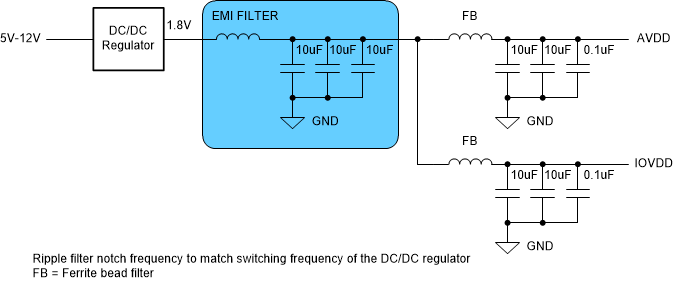JAJSM24A December 2023 – May 2024 ADC3910D025 , ADC3910D065 , ADC3910D125 , ADC3910S025 , ADC3910S065 , ADC3910S125
PRODUCTION DATA
- 1
- 1 特長
- 2 アプリケーション
- 3 概要
- 4 Pin Configuration and Functions
-
5 Specifications
- 5.1 Absolute Maximum Ratings
- 5.2 ESD Ratings
- 5.3 Recommended Operating Conditions
- 5.4 Thermal Information
- 5.5 Electrical Characteristics - Power Consumption
- 5.6 Electrical Characteristics - DC Specifications
- 5.7 Electrical Characteristics - AC Specifications (25 MSPS)
- 5.8 Electrical Characteristics - AC Specifications (65 MSPS)
- 5.9 Electrical Characteristics - AC Specifications (125 MSPS)
- 5.10 Timing Requirements
- 5.11 Output Interface Timing Diagram
- 5.12 Typical Characteristics - 25MSPS
- 5.13 Typical Characteristics - 65MSPS
- 5.14 Typical Characteristics - 125MSPS
-
6 Detailed Description
- 6.1 Overview
- 6.2 Functional Block Diagram
- 6.3 Feature Description
- 6.4 Device Functional Modes
- 6.5 Programming
- 6.6 Register Maps
- 7 Application Information Disclaimer
- 8 Device and Documentation Support
- 9 Revision History
- 10Mechanical, Packaging, and Orderable Information
7.4 Power Supply Recommendations
The ADC requires two different power-supplies. The AVDD rail provides power for the internal analog and digital circuits and the ADC itself while the IOVDD rail powers the digital interface. Power sequencing is not required.
The AVDD power supply must be low noise to achieve data sheet performance. In applications operating near DC, the 1/f noise contribution of the power supply also needs to be considered. The ADC is designed for very good PSRR which aids with the power supply filter design.
 Figure 7-4 Power
supply rejection ratio (PSRR) vs frequency
Figure 7-4 Power
supply rejection ratio (PSRR) vs frequencyThere are two recommended power-supply architectures:
- Step down using high-efficiency switching converters, followed by a second stage of regulation using a low noise LDO to provide switching noise reduction and improved voltage accuracy.
- Directly step down the final ADC supply voltage using high-efficiency switching converters. This approach provides the best efficiency, but care must be taken to make sure switching noise is minimized to prevent degraded ADC performance.
TI WEBENCH® Power Designer can be used to select and design the individual power-supply elements needed: see the WEBENCH® Power Designer
Recommended switching regulators for the first stage include the TPS62821, and similar devices.
Recommended low dropout (LDO) linear regulators include the TPS7A4701, TPS7A90, LP5901, and similar devices.
For the switch regulator only approach, the ripple filter must be designed with a notch frequency that aligns with the switching ripple frequency of the DC/DC converter. Note the switching frequency reported from WEBENCH® and design the EMI filter and capacitor combination to have the notch frequency centered as needed. Figure 7-5 and Figure 7-6 illustrate the two approaches.
AVDD and IOVDD supply voltages should not be shared to prevent digital switching noise from coupling into the analog signal chain.
 Figure 7-5 Example:
LDO Linear Regulator Approach
Figure 7-5 Example:
LDO Linear Regulator Approach Figure 7-6 Example:
Switcher-Only Approach
Figure 7-6 Example:
Switcher-Only Approach